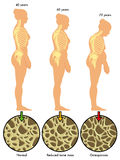Osteoporosis can lead to dowagers humps
Dowagers humps: Frequently asked questions:
1. What is it? Where did the term originate? If you have Osteoporosis of the spine, your vertebrae can fracture. This can cause Kyphosis or a Spinal back hump.
These fractures sometimes happen 'spontaneously' but they happen most often when a person bends forward from the waist or leans to the side to pick up something. (This is why competent physical therapy and yoga instructors always tell their clients NEVER to bend from the waist - only from the hips.)
Because so many women used to have untreated bone loss, this bent-over posture (Kyphosis) was associated with older women. Since the word dowager means a "dignified elderly woman" and since many older women developed this sort of back hump, people began to call this disfigurement a dowager's hump - even if the person with the kyphosis was a young woman or aman
2. How do dowagers hump happen?
When your spinal vertebrae lose a great deal of bone they become porous. They sometimes fracture spontaneously. This is most likely to happen if you bend forward from the waist, putting pressure on your spine. (In yoga, for example, practitioners are taught to ALWAYS bend from the hips- never from the waist. This keeps stress off spinal vertebrae.)
But many people bend forward from their waist during the day - reaching for things, loading a dishwasher - even sitting curled in a chair while reading or watching television.
NOTE: There are 3 types of spinal fractures that can occur in advanced osteoporosis.
- Wedge fracture - with this fracture the front of the vertebra collapses.
- Bioncave fracture - the midsection of the vertebra collapses.
- Crush fracture - the entire vertebra collapses. This type of fracture leads to lessening in overall height. You may notice that your health care provider measures your height at least once a year. They do this because a decrease in height can be an indication that your spine has had a crush fracture.

Dowagers humps (Kyphosis) are usually caused by wedge fractures. In this kind of fracture the front of a vertebra collapses. Since the back of the vertebra remains intact, the vertebra 'tips' forward and the spine becomes slightly misaligned and the section above the fracture tips forward making the back curve slightly.
As the vertebrae above your wedge fracture 'tip forward' they put stress on other vertebrae. This stress often causes another vertebra to develop a 'wedge fracture'. As more and more vertebrae collapse in wedge fractures, your back becomes more and more bowed. In very advanced cases of kyphosis a person can become severely bent over.
3. How will I know if I have a 'wedge fracture'? Are they painful?
Often a wedge fractures are 'silent'. They do not cause pain and so we do not notice them at all. Those that do cause pain are sometimes ignored since we are all used to 'back pains' and can dismiss the pain as another symptom of 'getting older'. If you notice a slight rounding of your upper back, or in that of a relative or friend, you may be seeing the beginnings of kyphosis or dowagers hump.
Sometimes a wedge fracture can lead to a loss of height. Again, this is one reason why your health care provider continues to measure your height during your annual examination.
Some spinal fractures do cause pain. So, if you have osteopenia or osteoporosis, pay attention to any pain that starts unexpectedly - especially pain that radiates forward towards your abdomen. It may be a sign of a vertebral fracture.
Often the pain is worse is you cough or sneeze. It is sometimes relieved when lying down. Some say that they have a feeling of 'fullness' or that lose their appetite after they have had a vertebral fracture. Sometimes the pain can be severe. If so see your health care provider. S/he may prescribe a pain reliever. The good news is that your pain will begin to subside after a few weeks and it often disappears entirely.
Is there anything that can be done about kyphosis or dowagers hump?
Yes, the good news is that there are several things that you can do.
- First and best intervention is to prevent spinal fractures from occurring in the first place....and if one has happend to prevent any more. Your bone loss can be reversed. If your dexa scans shows that you have bone loss, do read Osteopenia and Osteoporosis treatments that work.
- Second, there are things you should avoid if you want to prevent more spinal fractures. Exercises and activities to avoid
- Third, if you are having trouble sleeping because of your back hump, spinal pain do read: Choosing a mattress
- Fourth, you may want to consider some of the Medical treatments for back humps
Click to read: Natural treatments you can use to increase your bone density and avoid fractures of you spine.

